Northampton County, Pennsylvania
Sphingidae
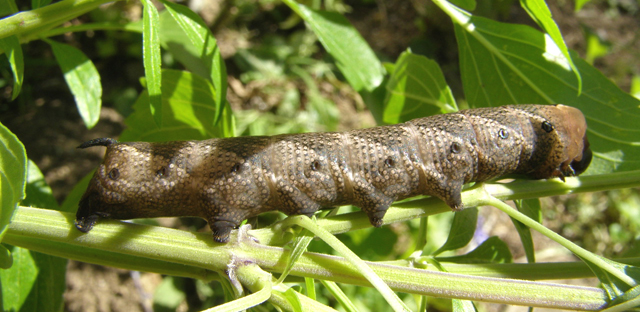
Sphinx eremitus, Northampton County, Pennsylvania,
courtesy of Karen Sauter.
This site has been created by
Bill Oehlke at oehlkew@islandtelecom.com
Comments, suggestions and/or additional information/sightings are welcomed by Bill.
This page is inspired by and dedicated to Karen Sauter, who sent me the the Sphinx eremitus larval image
(top of page) from Northampton County, Pennsylvania.
Karen writes, "We found a caterpillar for what we think is the Xylophanes tersa, Tersa Sphinx Moth.
"If we could rear it, it would be VERY interesting to my budding entomologist 8 y.o. son. We found it on our salvia plants, but we
need to make sure we are feeding it correctly. What would we need to do to over winter it?
"Any help would be great, we need to know if we should release it soon so it doesn't die."
I helped Karen with the identification and offered some suggestions on rearing and overwintering the pupa. Unfortunately the caterpillar died.
Karen writes, "Sad news. Although we've been checking on our caterpillar twice a day, yesterday we looked and it had died.
It has a parasite on it - small tufts of whitish hairs and little wormy looking things. One end of it turned to mush. What an awful way to die.
"Here we thought by keeping it somewhat isolated, we'd protect it from predators, but it was in vain.
"Sad day."
I explained to Karen that the death of the caterpillar was not her fault. It is a bug eat bug world out there and there are many
parasitic wasps and flies which deposit their eggs in the bodies of caterpillars or on the caterpillars' skins. Other insects also
prey on caterpillars, and there are many other predators (spiders, birds and other animals) that find them tasty. The damage to
this caterpillar had been done long before Karen and her son encountered it.
Most of the Sphingidae larvae are green and well camouflaged among the foliage they eat. Generally only one to five eggs are deposited
on a single host plant, and these larvae go unnoticed unless they are feeding on garden tomato plants (Manduca quinquemaculata and
Manduca sexta), in large numbers on Catalpa trees (Ceratomia catalpae), or on foliage of decorative flowers
(Hyles lineata on portulaca, and/or Xylophanes tersa on pentas).
If you have domestic grape vines or decorative Virginia Creeper growing on your property or nearby, you may encounter several of the others:
Eumorpha achemon, Eumorpha pandorus, Amphion floridenis, Darapsa myron, Deidamia inscriptum and Sphecodina abbottii.
many thanks to Pat Palmieri for confirming Specodina abbottii in Nazareth.
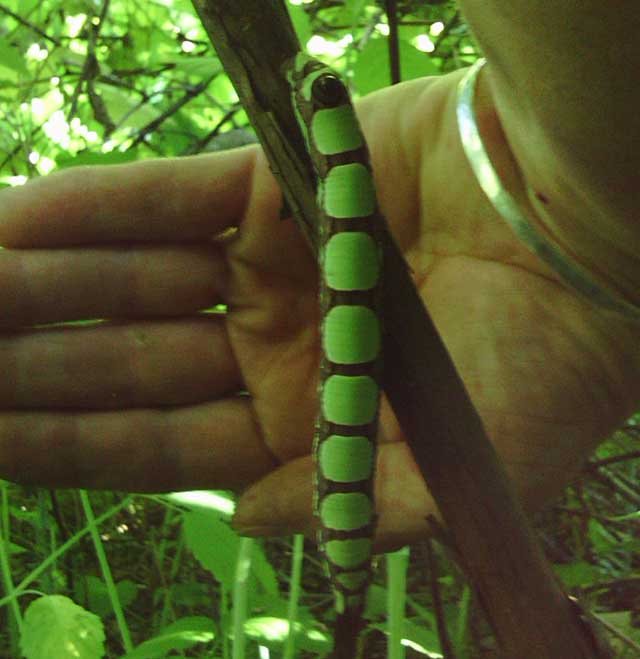
Sphecodina abbottii fifth instar, on grape,
Nazareth, Northampton County, Pennsylvania,
July 5, 2014, courtesy of Pat Palmieri.
Encounters with other species are less likely, but some of the larger species consume copious amounts of foliage, revealing their spectacular bulk.
Almost all of the Sphingidae larvae, at maturity, leave their foodplant hosts and crawl some distance from the plant to excavate subterranean chambers in
which to pupate. I frequently get asked to identify caterpillars discovered in this travel mode.
Most Sphingidae larvae have a well defined anal horn, harmless to humans, but probably threatening to some would-be predators.
The Eumorpha species and Specodina abbottii have the horn replaced by a raised "eye" in the final instar. The Lapara species
are without horns from the time of hatching.
For care of "found larvae/caterpillars" visit Manduca sexta larva, central Texas, August 21,
2008, Trina Woodall.
Visit Northampton County Sphingidae, Adult Moths.
Visit Pennsylvania Catocala, Underwing Moths.
Fifty Sphingidae species are listed for Pennsylvania on the U.S.G.S. website. Not all of the species are reported or anticipated in
Northampton County (fifteen are reported on U.S.G.S.). It is hoped that this checklist, with the thumbnails and notes, will help you
quickly identify the caterpillars you are might encounter.
A "WO" after the species name indicates that I (William Oehlke) expect that this species is present or might be present.
A "USGS" indicates the moth is reported on the USGS website and/or in Lepidoptera of North America, #1. Distribution of Silkmoths
(Saturniidae) and Hawkmoths (Sphingidae) of Eastern North America, an excellent little booklet available through Paul Opler.
Please help me develop this list with improved, documented accuracy by sending sightings (species, date, location), preferably with an
electronic image, via email to Bill Oehlke.
Agrius cingualata specimens have been recorded in Northampton County, but I do not believe the moth reproduces there. Sightings would be
only of adult moths, strays from further south.
Sphinginae subfamily
Sphingini tribe:
 |
Ceratomia amyntor
WO,
the Elm Sphinx or Four-horned Sphinx
Caterpillars show both brown and green forms and are unmistakeable
due to four horns on the thorax (near the head).
Larvae feed on Elm (Ulmus), birch (Betula), basswood (Tilia), and
cherry (Prunus). |
 |
This caterpillar is one of the few North American Sphingidae that
feed in large groups. Colouration is distinctive. The larvae
are much more spectacular than the moths. Catalpa is the larval host. |
 |
Note the pinkish-orange tail, spiracles outlined in red and the cream
stripes on the head.
The dramatic color change from the dorsal
yellow-green to the lateral light greyish-blue is not always
as intense as in this image.
|
 |
Note the smooth skin, blue-black horn and small black spiracles.
Pawpaw is the primary host. Littleleaf sweetfern, possum haw,
inkberry, tall gallberry holly and others are also utilized.
|
 |
This caterpillar is also without the anal horn and feeds on pines.
The long stripes and reddish brown afford great camouflage.
|
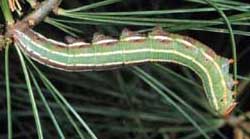 |
This caterpillar is also without the anal horn and feeds on pines.
The long stripes and reddish brown afford great camouflage. |
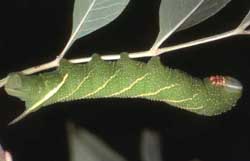 |
Larvae feed on ash in the Fraxinus genus. Syringa and Ulmus have
also been reported.
Note the black anal horn.
|
 |
Manduca quinquemaculata
USGS,
the Five-spotted Hawkmoth
Note the solid black horn and dark spiracular rings. In addition to the white
oblique lines, there are fainter white rings, especially on the back.
I suspect if you grow tomatoes, you are likely to encounter it.
|
 |
Note the green horn, raised white bumps and strong dark lines
anterior to the white ones.
|
 |
Note the red horn and black dots anterior to the white oblique lines.
If you grow tomatoes, you have probably encountered it.
|
 | Larvae feed at night, hiding on the underside of stems during the
day. Preferred hosts are common trumpetcreeper (Campsis radicans),
Florida yellow-trumpet (Tecoma stans), lilac
(Syringa species), and passionflower (Passiflora species). Questionable
|
 |
Sphinx chersis
WO,
the Northern Ash Sphinx or Great Ash Sphinx
Note pale blue horn and the creamy-white stripes on head.
The yellow form has a red horn.
Larval hosts are ash, lilac, privet, cherry and quaking aspen.
|
 |
Larvae hide in the day and feed primarily on cherry, plum, and apple
at night. Larvae have been found on Amelanchier nantuckensis
in Massachusetts and have been reared to pupation in Michigan on
Prunus serotina. Note purple oblique lines.
|
 |
Note triangular bump on the thorax.
Larval hosts are various species of beebalm (Monarda), mints (Mentha), bugleweed (Lycopis),
and sage (Salvia). Karen Sauter: larva: Sept 18 |
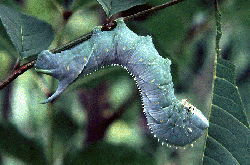 |
Larvae feed exclusively on various species of ash (Fraxinus).
Raised, pointed bumps, especially near the head and thorax give this
caterpillar a reptilian appearance.
|
 |
Larval hosts are apple (Malus), sweetfern (Myrica),
Carolina rose (Rosa carolina), blueberry and huckleberry
(Vaccinium), white spruce (Picea glauca), American
larch (Larix laricina), and alder (Alnus).
|
 |
In the final instar, the black on the head, lateral lines, horn and on abdominal
legs is diagnostic. Larvae feed primarily on lilac and fringe.
|
Smerinthini Tribe:
 |
Amorpha juglandis larvae feed upon Walnut and butternut (Juglans),
hickory (Carya), alder (Alnus), beech (Fagus),
hazelnut (Corylus), and hop-hornbeam (Ostrya).
|
 |
Pachysphinx modesta
USGS,
the Modest Sphinx or Poplar Sphinx
This moth is officially recorded in Northampton County. Larvae are
sometimes found on poplars and
willows.
|
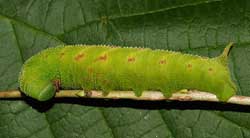 |
Blueberry and huckleberry (Vaccinium), cherries (Prunus) and
willows (Salix) are the favorites as larval foodplants.
|
 |
Larvae accept willows, birches, and cherries.
I have also found them in the wild on oak in eastern Canada.
|
 |
Paonias myops
USGS, the Small-eyed Sphinx
Wild cherry species are the favorites as larval foodplants, but eggs
will also be deposited on birches and other forest trees.
There are varying degrees in the amount of red markings along the sides.
|
 |
Larvae feed upon many forest trees including birches and cherries,
but are expecially fond of poplars and willows. Red markings on sides
vary greatly from specimen to specimen.
|
Macroglossinae subfamily
Dilophonotini tribe:
See Hemaris comparison to help distinguish
the next three species.
 |
Hemaris thysbe
USGS, the Hummingbird Clearwing
There is also an orangey-pink prepupal form. The lateral line runs
from S1 to the blue horn.
Hemaris thysbe larvae feed on viburnum and related plants.
|
 |
Hemaris diffinis
WO, the
Snowberry Clearwing or Bumblebee Moth
Larval host plants include Snowberry (Symphoricarpos),
honeysuckle (Lonicera), Coralberry, viburnums, Blue Dogbane
(Apocynum) and dwarf bush honeysuckle (Diervilla lonicera).
Horn is black with a yellow base.
|
 |
Hemaris gracilis WO, the
Slender Clearwing or Graceful Clearwing
Hemaris gracilis is distinguished from similar species by a pair of
red-brown bands on the undersides of the thorax, which varies from
green to yellow-green dorsally and sometimes brown with white
underneath. They have a red abdomen. unlikely
|
Philampelini tribe:
 |
Larvae feed upon Grape (Vitis), Virginia Creeper
(Parthenocissus quinquefolia) and other vines and ivies
(Ampelopsis).
Larvae occur in both a light (green) form and a darker (tan/brown)
form. Note six "segmented" oblique lines. |
 |
If you have Grape or Virginia Creeper nearby, then you might encounter
this species. Note the five large white ovals. There are orangey-brown and green
forms also. |
Macroglossini tribe:
 |
In additon to Virginia creeper larvae accept Grape (Vitis),
ampelopsis (Ampelopsis), and cayenne pepper (Capsicum).
Larvae are green until the final instar.
|
 |
Larvae feed on Azalea and Viburnum and progress very rapidly. The
larva to the left on Viburnum cassinoides is getting ready to
pupate. Color change from green to light burgundy-brown indicates
pupation is imminent.
|
 |
Darapsa myron
USGS, the Virginia Creeper Sphinx or the
Grapevine Sphinx
If you have the
foodplants indicated in the common names, you probably have this
species nearby. The lower wings are orange.
Larvae feed on Virginia creeper (Parthenocissus quinquefolia),
Grape (Vitis), Ampelopsis, and Viburnum.
|
 |
Larvae feed on Smooth hydrangea (Hydrangea arborescens),
buttonbush (Cephalanthus occidentalis), and waterwillow
(Decodon verticillatus).
Note small head which can be retracted into the thorax.
|
 |
Grape (Vitis), ampelopsis (Ampelopsis), and
Virginia creeper (Parthenocissus) all serve as larval hosts.
The alternating yellow and greyish-green rings across the back
distinguish this larva.
|
 |
Hyles lineata
USGS, the White-lined Sphinx
Larvae are highly varied and feed on a great diversity of plants
including willow weed (Epilobium), four o'clock (Mirabilis),
apple (Malus), evening primrose (Oenothera), elm
(Ulmus), grape (Vitis), tomato (Lycopersicon),
purslane (Portulaca), and Fuschia.
All larvae seem, however, to have the red/black swellings split by
dorso-lateral lines.
|
 |
Larvae feed at night on grape (Vitis) and ampelopsis
(Ampelopsis) and hide on the bark of their host plants during
the day. Virginia creeper would also be a suitable host. There is also a dark form
without the green patches. Note the "raised eye", replacing the anal horn.
|
Sphecodina abbottii on grape, Nazareth, July 5, 2014, courtesy of Pat Palmieri.
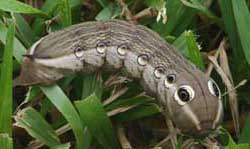 |
Larvae feed on Borreria, Catalpa
and Manettia spp. and
Smooth buttonplant (Spermacoce glabra) and starclusters
(Pentas species). They are also recorded on joe-pie weed and
Hamelia patens and on Hedoydis nigricans. The green form may be more
common.
|
|
|
Enjoy some of nature's wonderments, giant silk moth cocoons.
These cocoons are for sale winter and fall. Beautiful Saturniidae moths will emerge the following spring and summer.
Read Actias luna rearing article.
Additional online help available.
Eggs of many North American species are offered during the spring and summer. Occasionally
summer Actias luna and summer Antheraea polyphemus cocoons are available. Shipping to US destinations is done
from within the US.
Use your browser "Back" button to return to the previous page.
This page is brought to you by Bill Oehlke and the
WLSS. Pages are on space rented from Bizland. If you would like to become a "Patron of the Sphingidae Site", contact Bill.
Please send sightings/images to Bill. I will do my best to respond to requests for identification help.
 | 
Show appreciation for this site by clicking on flashing butterfly to the left.
The link will take you to a page with links to many insect sites. |







































